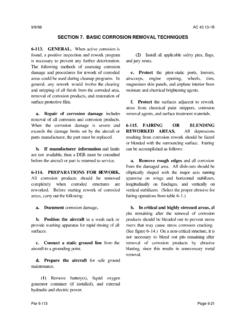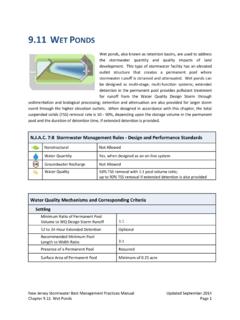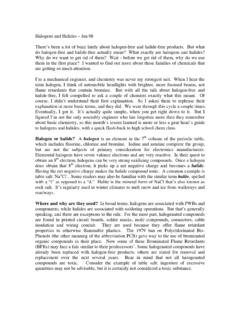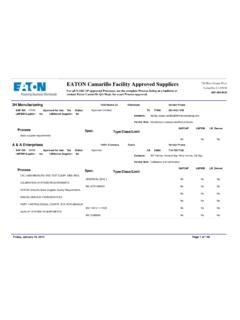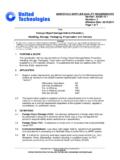Transcription of 200809 Standard Specifications for Casting Toleran
1 Copyright 2009, RapidProtoCasting Vancouver, WA 98685 United StatesPage1of8 Standard Specifications for Casting Tolerances-LinearDimensionsK. A. Silva, InForce RapidProtoCasting, Inc., Vancouver, WA USA 98685 ABSTRACTThis Standard provides guidance for Casting dimensiontolerances where no other requirements exist for form,fit or function (general tolerances). The generaltolerances presented in this paper are based oninternational and US standards for generalmanufactured component tolerances and castcomponent tolerances. These tolerances are establishedusing the basic size of the specific feature referred to bythe dimension and the tolerances are smaller for smalldimensions and larger for large dimensions ( , ) unlike traditional decimal placetolerances where the tolerance is established bythenumber of digits to the right of the decimal place ( , ). This paper does not addressmeasurement method, measurement error, statisticaluncertainty, statistical sampling, process capability, fitclass, preferred numbers ordrafting standards whichshould be specified separately and may be based onother international, US or company specification provides general toleranceguidance for lost-wax investment castings based on thebasic size of the specific feature referred to by specification is not intended to addressdimensional tolerances for features subject to specificform, fit or function in mm or inches that have been convertedfrom inches or mm using are 8062-3:2007 Geometrical productspecifications (GPS)-Dimensional and geometricaltolerances for moulded parts-Part 3: Generaldimensional and geometrical and machiningallowances for castings, hereinafterISO8062 8062.
2 1994 Castings--System of dimensionaltolerances and machining allowances, hereinafterISO 8062 Castings Handbook, Supplement 3, 2003 Dimensional Capabilities of Steel Castings, SteelFounders Society of America, Casting Handbook, 1997, InvestmentCasting Institute, hereinafterICI 286-2:1988 ISO system of limits and fits-Part2:Tables of Standard tolerance grades and limitdeviations for holes and shafts, (R1999) Preferred Limitsand Fits for Cylindrical Parts, 2768-1:1989(E) General Tolerances-Part 1:Tolerances for linear and angular dimensionswithout individual tolerance indications,hereinafterISO Dimension: The theoretical exact size, shapeor location of a feature without tolerance. The basicdimension is used for establishing the dimensiontolerance for the feature and not the actual example, a feature with aspecified width of 30mmhas a tolerance per ISO 286-2 JS-14 of measurement the actual dimension is found tobe Per ISO 286-2 JS-14 a dimension has a tolerance of Because thetheoretical exact size of the feature is 30mm the must be used and the feature width is out-of- specification .
3 If no dimensioned 2D drawing isprovided, the basic dimension is the feature dimensionfrom the 3D solid Shrink: Pattern shrink is the differenceinsize and shape between the wax or plastic injection tool Copyright 2009, RapidProtoCasting Vancouver, WA 98685 United StatesPage2of8cavity as it is machined and the final wax or plasticpattern after the injected part has cooled. Pattern shrinkis a function of the injection tool size, injection tooltype, pattern material,injection parameters and thetemperature of the measured Shrink: Casting shrink is the difference insize and shape between the pattern received by thecasting supplier and Casting following cooling, cleaningand finishing. Casting shrink isa function of theceramic investment process, Casting process, metaltype, material lost during ceramic shell removal,material changes during surface defect removal andsurface finishing and the temperature of the Dimensional Changes: Post-processing of the cast part can increase or decreasefeature dimensions.
4 Shrinkage of the Casting occursdue to hot isostatic pressing to remove sub-surfacedefects, heat treating to improve mechanical andchemical properties of the castmetal and surfacecleaning (chemical milling, sand-blasting, etc.) toremove oxide and surface reaction layers. Surfacehardening, plating and coating can increase feature sizefollowing Casting and heat FOR ACHIEVINGTOLERANCESR esponsibility for achieving dimensional tolerances ofthe finished Casting for delivery to the buyer rests withthe Casting supplier if the Casting supplier is responsiblefor providing the patterns and post-processing of thecasting. If different parties, including the buyer and thecasting supplier, share responsibility for providing thepatterns, manufacturing the castings, heat treating thecastings and post-processing operations, then one partymust be responsible for ensuring the various suppliersdeliver their product to dimensions and tolerancescalculated to yield an acceptable finished Shrink: The lost-wax investment castingprocess uses one expendable pattern to create eachcasting.
5 Patterns may be rapid prototypes, wax patternscreated using a wax injection tool, plastic patternscreated using a plastic injected tool, low melting pointmetal parts (zinc, magnesium, aluminum, etc.)fabricated by machining, die Casting or silicon moldcasting or machined plastic or low-melting point alloymetal parts. The size and shape of the castings areprimarily established by the size and shape of thepatterns used and primary responsibility for castingsmeeting specified dimensions and tolerances rests withthe party responsible for the patterns. Typical ASTM Specifications for investment castings, including ASTMA957/A957M-06, Standard Specifications forInvestment Castings, Steel and Alloy, CommonRequirements, for General Industrial Use, do notspecify dimensional tolerances and state "All castingsshall be made in a workmanlike manner and shallconform to the dimensions on the drawings furnishedby the purchaser before manufacture is started.
6 If thepattern is supplied by the purchaser or is producedusing a die supplied by the purchaser, the dimensions ofthe Casting shall be as predicated by the pattern or die."Typical ISO Specifications including ISO 8062:1994 Castings-System Of Dimensional Tolerances AndMachining Allowances state The system specifiedapplies when the foundry provides the pattern or dieequipment or accepts responsibility for proving it. Casting Shrink: The Casting supplier is responsiblefor determining shrinkage during the investing, castingand finishing process and providing the shrinkage valueto the pattern Dimensional Changes: The partyresponsible for post-processing of the cast part isresponsible for providing finished surface dimensionalchange values to the Casting supplier and the patternsupplier. The Casting supplier istypically responsiblefor hot isostatic pressing and heat treating and theseshrinkage values can be added into the Casting shrinkvalues to provide a single shrinkage value for the heattreated Casting relative to the pattern CHARACTERISTICSThe primary influence of pattern dimensions on thefinal Casting dimensionshas been described inDefinitions and Responsibility for AchievingTolerances.
7 Different pattern types possessdimensional characteristics that strongly influence thefinal dimensions and dimensional variation of thefinished castings. In addition, systematic improvementscan be made to finished Casting dimensions anddimensional variation by refining the pattern size for asubsequent cycle of Casting after measuring finishedcastings from a previous cycle. Multiple developmentcycles consisting of pattern fabrication, Casting , castingmeasurement and pattern adjustment can substantiallyreduce finished Casting variation from basicdimensions. Copyright 2009, RapidProtoCasting Vancouver, WA 98685 United StatesPage3of8 Rapid Prototype patterns: Large feature tolerancesare moderate due to the lack of volumetric shrinkagecompared to wax and plastic injected patterns. Smallfeature tolerances may belargedue to inaccuraciesinherent in certain additive fabrication processes andsurface finish which maybe rougher than wax or plasticinjected injected patterns:Large feature tolerancesmay be high due to volumetric shrinkage.
8 Small featuretolerances may be high due to fill issues and injected patterns:Large feature tolerancesmay be high due to volumetric shrinkage. Plasticpatterns provide the best (lowest) small featuretolerances compared to rapid prototype and waxinjected melting point metal partsmay be fabricatedby machining, die Casting or silicon mold Casting andthe tolerances are established by the production processemployed. Machined or die cast low melting pointmetal parts are typically used when transitioning from anon-ferrous alloy part to a cast part with improvedmechanical or corrosion resistant plastic patternsare an excellentalternative to rapid prototype patterns for easy tomachine designs and low volume applications. Surfacefinish and dimensional accuracy have a strong impacton machined pattern cost patternsmay be assembled from rapidprototypes, wax or plastic injected parts and machinedplastic parts to create complex assemblies where thefinal assembly may be difficult or cost prohibitive tofabricate as a single TOLERANCE SYSTEMST hree types of tolerance systems are used for castings: Casting Tolerance Systems: The tolerance systemsset forth in ISO 8062:2007, ISO 8062:1994, SFSA2003 and ICI 1997 are specifically intended as generaltolerances for investmentcastings.
9 These systemsinclude linear, angular and geometrical tolerances andmay also include machining allowances, processcapability recommendations and general toleranceguidelines for different types of Tolerance Systems: The tolerancesystems setforth in ISO 286-2 Limit deviations for holes and shaftsand ANSI are specifically intended for fitsbetween two or more parts that must assemble orfunction together. These systems include tolerances forinternal dimensions (holes)and external dimensions(shafts) that will result in locational fits, running andsliding fits and force Tolerance Systems: standards ISO 286-2 Standard Tolerances and ISO 2768-1 provide tolerancesystems independent of fit requirements andmayprovide recommendations for tolerances based onprocessing CHARACTERISTICST olerances for the referenced standards are summarizedin Tables 1 (mm) and 2 (inches) and Charts 1 (mm) and2 (inches). The tolerance groups set forth in the variousstandards have certain characteristics which can beimportant when selecting a Standard for use, including:ISO 8062:2007, ISO 8062:1994 and SFSA 2003:These tolerancesystemsare representative of currentinvestment Casting processes using conventional patternfabrication techniques.
10 There are sixteen tolerancegrades ranging from 25 mm to 25 12 mm andthe tolerances increase approximately 100% between 0and 250mm: DCTG-4 10 mm to 250 standards offera wideselection of gradeshowever the tolerance range is small compared to allother standards and selecting a class with tighttolerances for the small feature basic dimensions mayresult in excessively tight tolerances for larger 1999: The ICItolerance systemprovides a singleset of tolerances with a 4x tolerance range between 0and 250mm:25 to 250 mm. The ICI1999 tolerances are very similar to ISO 286-2 Class 286-2 Standard Tolerances, IT class: Thissystemprovidestwentytolerancegrades with a 5xrange of tolerances: IT143 mm to 250 The number of grade choices and wide tolerancerange provides options for balancing cast part accuracyand 286-2 External Dimensions, JS class: Thissystem is similar to the ISO 286-2 Standard Toleranceswith two important exceptions, (1) the tolerance rangevaries, with the tighter JS-13 system having a tolerancerange of 3 and 250 mmand the loose JS-15 system having a tolerance range of , and (2) thissystem provides relationships to a structured system ofshaft and hole tolerance zones that can be used to Copyright 2009, RapidProtoCasting Vancouver, WA 98685 United StatesPage4of8specify tolerances for features with specific form, fit orfunction : This system is similar to the ISO 286-2 StandardTolerance, IT class 2768-1.
